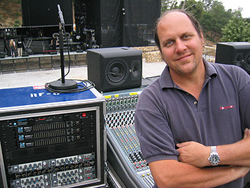
The tracks were made up of a combination of direct outputs from the inputs of the Midas XL4 house console as well as group outputs. By storing a second program on the XL4, and returning the tracks into line inputs on the same input modules, I could assign the same EQ and processing to the raw tracks.
Perhaps the easiest way to detail this setup is to look at it input by input:
Tracks 1 – 2: The first two inputs were the dual kick drum inputs. I took both inputs of an Audio-Technica (A-T) AE2500 microphone and assigned them pre-fader, pre-EQ and pre-insert to the direct outputs.
During playback, these came in the same modules (in line input), through the same EQ, and through the same Drawmer 241 compressor/gates that the original signal chain contained.
Track 3: Combination of the snare top mic (Shure Beta 57A) with the bottom snare mic (A-T AE3000) to a single track. Since these were combined and would be returning in one input, the EQ and processing was also “‘printed.”
Another Drawmer 241 on the snare top – this was return for playback in the first snare channel on the console, with the EQ bypassed (already EQ’d, remember?), but still using the reverb sends for various songs on the input. (In addition, effects from Lexicon PCM-70 and Kurzweil KSP-8 as well as a stereo sub-mix to a Empirical Labs FATSO Jr. for part of the drum sound).
Track 4: The hi-hat channel, with an A-T AE5100 “pre everything” to the converters. Returned in the line input of the hi-hat channel and EQ.
Tracks 5 – 6: A stereo sub mix of the rest of the drum kit. The two rack toms were mic’d with Shure Beta 98s, and the floor tom mic’d with an A-T AE3000. The overheads were on A-T 4050s. These were assigned to two groups and recorded that way. They returned in the two overhead channels, with the EQ bypassed.
Track 7: A sub mix of the three different inputs on the bass. I took an input from a Radial DI (direct box) for the straight signal and run that through an Empirical Labs Distressor at about a 3:1 ratio. Pretty light compression.
In addition, I took the output of a Bass Pod that is in the bass rack that is used for a couple of small parts in the show for a “synth-type” sound. On top of those, I mic’d the bass player’s SVT with a CAD M179 microphone and ran that through another Distressor set pretty extremely – set in “Nuke” mode with the third harmonic distortion selected.
This, when combined with the dry signals, gave the bass a really nice “assertiveness,” definitely a rock ‘n’ roll bass sound. This track was then returned in the first bass channel on the console, with the EQ bypassed and inserts bypassed.
Tracks 8 – 9: The pair of stereo guitar sub group tracks. This was a fairly involved, with a lot of things done to the various guitars during the show. The tracks are recorded taking two group outputs from the console, while I took three mic inputs from the electric guitar rig.
The first two were supplied another A-T AE2500 dual element mic, with the condenser side panned center and the dynamic side panned hard left. Then I added a Shure SM57 panned hard right going through a 15-millisecond delay program via the Kurzweil KSP8. This gives a nice spread even though it’s really a mono guitar rig.
The acoustics ran through Radial DI boxes panned center, with the acoustic signal also feeding a “spatial widening” program on the KSP8. It widened the material without any movement that a chorus would do.
All of the guitars fed through the same two groups, with an ADL Stereo Valve limiter inserted across them. This was done so that when I boosted the VCA for a guitar solo, the signal became really nicely compressed and “jumped out.”
This “stereo” signal returned through two of the guitar inputs for soundchecking purposes with the EQ and inserts bypassed, as they were already treated.
